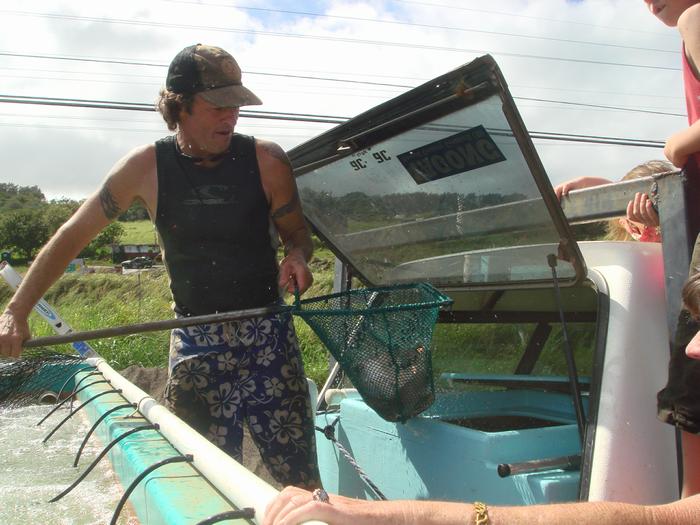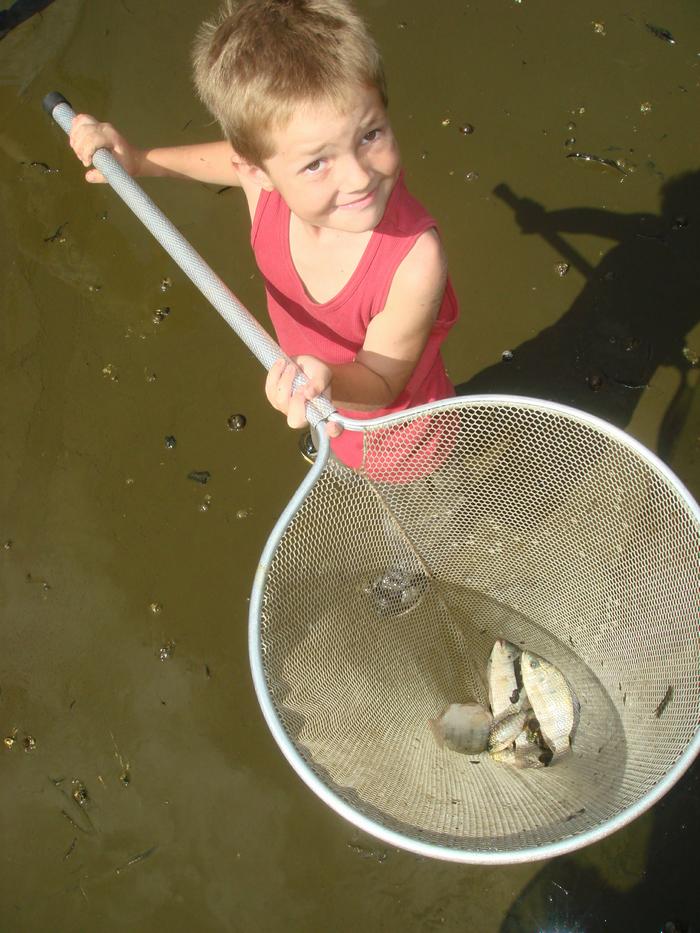How To Keep Your Fish Healthy and Alive When Hauling
IMPORTANT- You can kill fish with bad hauling techniques! Even if you’re getting your fish from a pond or lake on your property, you still need to haul them a short distance to get them into your aquaponic system. Hauling fish stresses them and even on the best and most careful fish hauls we’ve done (and we have a GREAT haul tank with lots of aeration that has good oxygen levels even with 300 lbs. of fish in it), we still lose about half a percent of them. If you have a bad haul that stresses your fish, OR your fish supplier stresses them without your knowledge before you pick them up, you can lose up to 20% OR MORE!
(Below) Hauling our first fish; you can see the haul tank inside the pickup to the right, and the fish tank we were delivering into on the left side of the photo.
Here’s what this looks like: your supplier, not caring much about how long the fish survive after he’s been paid, has pumped the fish tank down so there’s only about 10 inches of water in it and the fish are less work for him to catch. The problem is, he didn’t do this when you arrived, he did it last night, and the fish have been stressing in this too-shallow water for 12 hours now.
Now, when the fish are transferred to your haul tank, they are already stressed, have lost a lot of their slime coats (this affects fish in the same way that losing skin affects a person: badly!), and some of them are already dying. It just won’t become obvious for another day or two. You have to get them out of the haul tank with a net when you get home, which stresses them further. Then they’re introduced to completely different water than they came from, which may stress them further. Unless you’re really observant (and know to look for this), and check the bottom of the fish tank with a long-handled net two or three times a day, the first time you may notice a problem is a couple of days after the haul, when the first dead fish floats to the top of the fish tank, and you remove it.
The problem is that this fish has been dead for a day or two before it floats to the top, and has been pouring ammonia (a product of decomposition of decaying organic material) into the tank the whole time. If you had a bad haul with fish that were stressed before you even loaded them, and lose 20%, this can show up as fish dying for the next two weeks or so, with an attendant huge ammonia problem (more about that in just a bit). How you reduce or eliminate this problem before you ever transport your fish is do as many of the following as you can:
1. Make sure your fish supplier handles the fish gently and professionally before they are loaded into your haul tank, and load them with as little and as gentle handling as possible. Hard handling will stress the fish and increase your loss.
2. Haul with a tank that is filled to the top with water and has a solid cover battened down on top of the water. This will ensure that the tank water doesn’t slosh, as it will in a partially full haul tank or one with no top! Sloshing inside the tank will stress the fish and increase your loss.
3. Make sure your haul tank has plenty of airstones and enough air pump capacity to drive them. You can get cheap air pumps (Aquatic EcoSystems catalog number DW9622), which only use 8 watts; you can run up to 6 of these off a $15 AC inverter that plugs into your cigarette lighter. One of these air pumps will keep about 30 lbs. of fish alive for a two- to three-hour haul. If you don’t have a haul tank with a tight lid, putting the fish in those sturdy grey 42-gallon garbage cans and lashing the lids down with bungee cords works just fine, and will keep 30 pounds of fish alive. You can drill a hole in the middle of the lid and run the airstone tubing down through this hole, then put the airstone at the bottom of the garbage can. FILL IT TO THE TOP SO IT DOESN’T SLOSH!
4. Handle the fish as little as necessary and as gently as possible when you transfer them from the haul tank to the fish tank at home.
5. Check the bottom of the fish tank with a big net the next morning and about two to three times daily for the first few days to get dead fish out of the tank before they add a lot of ammonia to your system and cause a problem. If you have dead fish, get them out of the tank as soon as possible after they die. If you see a fish swimming or acting strangely at the surface, get it out of the tank. It won’t recover, and you might as well get it out before it adds ammonia to the tank.
6. DON’T feed the fish until they stop dying; even if you have a good haul and no mortalities, don’t feed the fish for the first few days to a week. They won’t like it, but it won’t hurt them, and it will ensure that your ammonia levels stay low.
(Below) Fish are Fun!
Now you’ve got your fish home, they’ve been in the tank for about a week, your ammonia level is nice and low (under 2 ppm), the fish are accepting food, and your mortalities have ceased. Another week goes by, and you notice a couple of dead fish one morning. What’s this? You will see two separate periods of mortality coming from a bad haul. The first one is usually over in the first three or four days after the haul; and consists of the fish that were so badly damaged in the haul that they died relatively soon from their injuries and trauma.
This second batch of mortalities that sometimes occurs from ten days to two weeks after the haul are (we believe) fish that were lightly damaged during the haul, not enough to kill them outright, but enough to compromise their immune systems. These fish basically caught colds and died from them because they were so weak. We’ve never been able to identify a true “fish disease” incident in either the first or second batch of post-haul mortalities. Get these dead fish out of the system as fast as possible to avoid adding unnecessary ammonia.
Leave a Reply